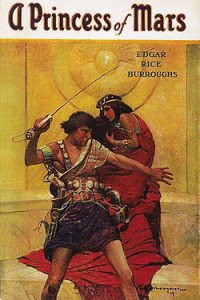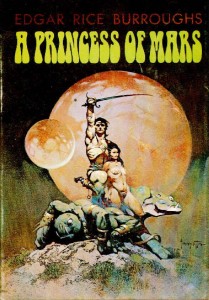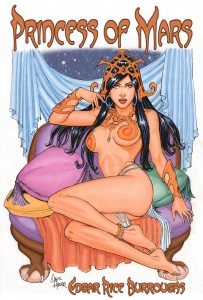Title: A Princess of Mars
Author: Edgar Rice Burroughs
Genre: Science Fiction
Length: 81 pages
Read: June 16-19, 2012
Summary: Pulp fun
Watching John Carter got me to reread A Princess of Mars. I barely remembered anything of the book, and it’s only 81 pages, plus the Kindle version was free!
It’s definitely superior to the film, and good campy pulp fun. Plus, when you take into account it’s 1917 publication date, it’s actually pretty impressive!
The writing itself is fast and clean, even if the sentences include copious subordinate clauses, high falutin vocabulary, and the occasional archaic turn of phrase. Like “fetich” which my Kindle dictionary informed me is a dated spelling of “fetish.” The style suffers a little — by modern standards — from an overabundance of “tell.” The book moves rapidly and the narrator tells you in a straightforward first-person past what happened. He doesn’t illustrate the points by action, but calls it as he sees it. Even the action is given to narrative summary rather than blow by blow description. This is compact and functional but feels dated.
The plot is a straightforward adventure. Our protagonist, who is pretty much great at everything, hurls himself from one predicament to the next, all the while extracting maximum drama and showmanship. Things rarely go badly for him, and there is little subtly of choice. I can see how significant an effect Burroughs had on mid century pulp Science Fiction masters like Phillip Jose Farmer or L. Ron Hubbard (I’m ignoring the religion and talking about the writer). Farmer adventures like Dark is the Sun, World of Tiers, or The Cache feel like direct descendants of A Princess of Mars.
For 1917, the world building is fairly extensive. There aren’t too many outer space adventure novels before this, so he must have invented a lot of the tropes. There are flying craft, exploding bullets, terraforming machines, and all sorts of goodies. And all in an era when the biplane was the height of aeronautical tech.
The book’s biggest weakness is the utter lack of subtlety. John Carter is able to instantly read into alien situations and ferret out the meaning — even when he can’t understand the language. He is an instant master of the new tech, a perfect navigator, etc. The solution to his problems are usually readily available. Burroughs resorts to certain devices — like convenient eavesdropping — multiple times. The “romance” between Carter and Dejah Thoris is formulaic at best. Still, she is described repeatedly as gorgeous and nearly naked, which sets the standard for pulp heroines.
As a student of media conversions, I continue to wonder at the bungles in the recent film adaptation. Read my thoughts on the John Carter film here, but while they borrowed most of the characters, situations, and feel from the novel, they made many plot changes for the worse. Some of the camp factor does come from the source material, and there would probably be a need to simplify the action, however this doesn’t excuse the addition of multiple prologues, and ridiculous meta-villains. Pulp action is pulp action. Dressing it up with an extra layer of plot complexity doesn’t change that.
For more book reviews, click here.







